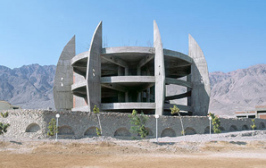Architecture Fiction: Premonitions of the Here and Now
"The billionaire goes for long walks at night alone amongst the ruins, sweeping dust from recent sandstorms off windowsills and open doorways. At night, when the stars come out, different constellations are framed by unglazed windows, as if justifying these concrete forms from above with the poetic force of celestial geometry."
By Mark Dery

Architecture fiction anticipates the future present.
The sci-fi subgenre is exemplified by short stories such as Bruce Sterling’s “White Fungus,” a post-recession vision of exurbia regained, where farmers grow cash crops on the crabgrass frontier and “derelict buildings [are] gutted and transformed into hydroponic racks,” transforming what was once farmland, before sprawl rolled over it, back into farmland. “Naturally, no [exurban bobos] wanted this logical solution,” writes Sterling.
Farming was harsh, dull, boring, patient work, and no one was going to pay the locals to farm. So, by the standards of the past, our survival was impossible. The solution was making the defeat of our hunger look like fun. People gardened in five-minute intervals, by meshing webcams with handsets. A tomato vine ready to pick sent someone an SMS. Game-playing gardeners cashed in their points at local market stalls and restaurants. This scheme was an “architecture of participation.” [i]
The most exciting thing about architecture fiction is that no one—not even Sterling, who coined the term in 2003 [ii] — has managed to theorize a definition whose point is sharp enough to pin the concept, wriggling, to the page. Is “architecture fiction” what happens at the utopian edge of visionary architecture, where blueprints for a better world lift off from earthbound considerations—building codes, architectural review boards, investors, engineers—and ascend into the dizzyingly thin air of pure fantasy? Mark Wigley, Dean of the Graduate School of Architecture at Columbia University, has argued that “science fiction is an incredibly important mode of theorizing” and that “the people who produce science fiction are often incredibly canny theorists”; inversely, can’t architectural theory, at its most deliriously visionary, be science fiction? [iii]
Sterling seems to suggest as much in a 2003 blog post about the Swinging London group Archigram, who were to ‘60s architecture what Richard Hamilton was to Pop art. “‘Plug-in City,’ ‘Living Pod,’ ‘Instant City,’ and ‘Ad Hoc,’” enthuses Sterling. “Manzak,’ ‘Suitaloon,’ ‘Cushicle,’ ‘Blow out Village,’ ‘Gasket Homes’ and the ‘Walking City.’ Archigram never actually built anything. Basically, they were composing ‘AF’—‘Architecture Fiction.’”[iv]

Of course, by that logic, much postmodern “paper” architecture—hyperrealistic renderings of reified ideas, unbuildable buildings inspired by French philosophers like Derrida and Deleuze and expressed in the form of slithery, digital blobs—is architecture fiction. Kazys Varnelis, the Director of the Network Architecture Lab at the Columbia University Graduate School of Architecture, Planning, and Preservation, wonders if architecture fiction is what happens when architecture shapes “our experiences in such ways as to approximate the effects of films or fiction? Or better yet, video games?” [v]
Following Varnelis’s logic, I can’t help seeing the Machinima [vi] movie My Trip to Liberty City as architecture fiction. An unassuming masterpiece of Baudrillardian shtick, My Trip follows a virtual flaneur around the urban environment of the hyperviolent Grand Theft Auto; refusing to play by the rules, the narrator—an earnest, softspoken Canadian tourist—free-associates about the city as he rambles, slyly interrogating the unquestioned conventions of virtual urbanism (and gameplay in general) in an ingenuous deadpan that never cracks. [vii]
Whatever it is, architecture fiction seems to grow out of the graphical (and, nowadays, digital) conjurations of visionary architects, which the architect-theorist Pedro Gadanho describes as “fictional depictions of unexisting, speculative architectures, namely through techniques of photomontage. [viii]
Blogger Geoff Manaugh is an accomplished auteur of architecture fiction in the sense that David Gissen, a professor of architecture and visual studies at the California College of the Arts, uses the term. For Gissen, AF is architecture criticism that appropriates the tropes and poetic license of fiction in order to “[rethink] the relation between writing and building…[involving some new foreclosure between the written and the built that remains to be staged.” [ix] On BLDGBLOG, Manaugh reads the built environment like an MRI, scanning it for evidence of cultural pathologies, premonitions of the post-apocalyptic. In “Hotels in the Afterlife,” he prowls “‘the concrete skeletons of five-star hotel complexes’ abandoned on Egypt’s Sinai Peninsula…resorts that never quite happened…with names like Sultan’s Palace and the Magic Life Imperial…‘monuments to failed investment.’” To Manaugh, the hotels look like architectural fossils bleaching in the desert, “or derelict abstractions, as if some aging and half-crazed billionaire had constructed an eccentric sculpture park for himself amongst the dunes.” Then, he modulates, without so much as a leading tone, into the key of the future now:
The billionaire goes for long walks at night alone amongst the ruins, sweeping dust from recent sandstorms off windowsills and open doorways.
At night, when the stars come out, different constellations are framed by unglazed windows, as if justifying these concrete forms from above with the poetic force of celestial geometry.
Or, for that matter, five years from now these deserted monuments simply disappear—but because they’ve been put to use, finally, enwrapped with drywall and plaster, fitted out with drapes and marble floors, and you can sleep inside them for $300 a night, never even dreaming that these hotels were once ruins, temporarily abandoned to the sand and only recently reclaimed.
The empty swimming pool is now full—and you dive into it, unaware that you’re more like a ghost than a tourist, haunting the afterlife of these sites in bleaching sunlight. [x]
Echoing with the lyricism of Ray Bradbury’s Martian Chronicles and Ballard’s short-story collection—song cycle, really—“Vermillion Sands,” Manaugh’s post augurs the here and now, throws wide the doors of our imaginations to a speculative present, where the econopocalypse and the ecotastrophe have already happened.

Shift your line of sight, ever so slightly, and you’ll see things from a parallax view: the American heartland abandoned, hollow-eyed towns reclaimed by savannah and repopulated by wildlife; squatters hunkered down in the repossessed McMansions of California’s gated communities, whose mazelike streets are ruled after dark by entrepreneurial packs, half-feral dog, half-coyote. The credit card is fast becoming a postmodern fossil; barter is back, and some burbclaves are printing their own currency. Out on exurbia’s wild edge, the crabgrass frontier is reverting to chaparral and coyotes are obligingly thinning the population of pets gone feral.
Fabulists of the here and now, the unwritten myths of the future present are calling your name. ![]()





